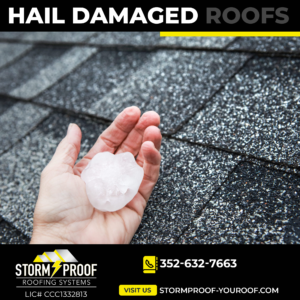Ride Out Any Storm with Confidence: The Power of Storm Proof Roofing Systems and How to Find a Contractor That Delivers Results
Introduction
The Importance of a Strong and Durable Roofing System
Your roof is one of the most important components of your home. It protects you and your family from the elements, keeps you warm and dry, and provides shelter from the sun. Without a strong and durable roofing system, your home is vulnerable to damage from wind, rain, hail, snow, and other weather conditions.
A damaged or leaky roof can also lead to more serious problems such as mold growth or structural damage. That’s why it’s crucial to have a strong and reliable roofing system in place.
Introducing Storm Proof Roofing Systems as a Solution for Homeowners
If you live in an area prone to severe weather conditions such as hurricanes or tornadoes, you need a roofing system that can withstand those harsh conditions. That’s where storm proof roofing systems come in.
Storm proof roofing systems are designed to be stronger and more durable than traditional roofs. They use materials that are specifically engineered to withstand extreme weather conditions such as high winds, heavy rain, hailstorms, and even flying debris.
By installing a storm proof roofing system on your home, you can have peace of mind knowing that your roof will be able to withstand whatever Mother Nature throws its way. In the next section, we’ll take a closer look at what storm proof roofing systems are and how they differ from traditional roofing systems.
What are Storm Proof Roofing Systems?
Roofing systems have been around for centuries, but with the increasing frequency of severe weather events such as hurricanes, tornadoes, hailstorms, and heavy rainfall, traditional roofing systems are no longer enough to protect homes and businesses. That’s where storm proof roofing systems come in.
Storm proof roofing systems are designed to withstand extreme weather conditions that traditional roofs may not be able to handle. These roofs are engineered with advanced materials and installation techniques to provide superior protection against wind, rain, hail, and other natural disasters.
Definition of Storm Proof Roofing Systems
Storm proof roofing systems can encompass a variety of materials and installation methods. Essentially, they are designed to meet or exceed industry standards for wind resistance and waterproofing.
They can be made from materials such as metal, asphalt shingles or tiles that have been reinforced with additional layers or coatings for added durability. These roofs must pass rigorous tests by independent third-party organizations that evaluate their ability to withstand high winds and flying debris.
The tests simulate the impact of a severe storm on a home’s roof. Only those roofing systems that meet the established criteria receive certification as being “storm-proof.”
How They Differ From Traditional Roofing Systems
Traditional roofing systems typically consist of asphalt shingles or tiles laid over a layer of felt paper on top of wooden decking. While these types of roofs can last for an extended period under normal conditions if installed correctly but can be easily damaged during severe weather events.
In contrast, storm proof roofing systems use advanced material technologies such as polymer-modified bitumen sheets or specially engineered metal panels that interlock tightly together with hidden fasteners creating an impenetrable barrier against water leaks and wind damage. Additionally, many stormproof roofing solutions include multiple layers of protection such as insulation boards placed beneath the outer layer to provide added thermal resistance and impact absorption.
Materials Used in Storm Proof Roofing Systems
Storm proof roofing systems use a variety of durable materials to provide superior protection against the elements. These materials include: – Metal: Metal roofs are often used in storm proof roofing systems because they offer excellent wind resistance and are highly durable.
They come in a variety of styles and colors, making them an aesthetically pleasing option for homeowners. – Asphalt shingles: Asphalt shingles can be reinforced with polymer or fiberglass fibers to increase their wind resistance.
They’re also lightweight, easy to install, and relatively inexpensive compared to other storm proof roofing materials. – Tiles: Roof tiles made from clay or concrete can also be reinforced with additional layers for added durability.
They come in a range of colors and styles, making them a popular choice for homeowners who want an attractive roof that can withstand harsh weather conditions. Storm proof roofing systems are designed to protect homes and businesses from severe weather events such as hurricanes, tornadoes, hailstorms, and heavy rainfall.
These roofs differ from traditional roofs by using advanced materials and installation techniques that provide superior protection against wind damage and leaks. Materials used in storm proof roofing systems include metal, asphalt shingles or tiles that have been reinforced with additional layers or coatings for added durability.
The Benefits of Storm Proof Roofing Systems
Stronger and More Durable Than Traditional Roofs
One of the main benefits of storm proof roofing systems is their increased durability and longevity compared to traditional roofs. The materials used in these types of roofs are designed to withstand extreme weather conditions, such as heavy rain, strong winds, and hailstorms.
This means that homeowners who invest in a storm proof roofing system can expect their roof to last longer without needing repairs or replacements. In addition to being more durable, storm proof roofing systems are also stronger than traditional roofs.
They are designed to be able to resist high wind speeds, which can help prevent damage from occurring during a hurricane or other severe weather event. This added strength also makes it less likely for shingles or tiles to come loose and cause leaks.
Protection Against Extreme Weather Conditions
Another benefit of storm proof roofing systems is the protection they provide against extreme weather conditions such as hail, wind, and heavy rain. These types of weather events can cause significant damage to traditional roofs, leading to leaks and other issues that may require costly repairs. Storm proof roofing systems are designed with these types of weather events in mind.
They feature materials that are resistant to damage from hailstones and can handle heavy downpours without leaking. In areas prone to hurricanes or tornadoes, homeowners with storm proof roofing systems can rest easy knowing their homes are better protected against high winds.
Potential Savings on Insurance Premiums
Investing in a storm proof roofing system may lead to potential savings on insurance premiums. Some insurance companies offer discounts for homeowners who have installed certain types of roof systems that are resistant to wind and hail damage.
While the initial cost of installing a storm proof roofing system may be higher than traditional roofs, the potential savings on insurance premiums over time could make up for the added expense. Plus, homeowners will have the peace of mind knowing their home is protected from severe weather events and potential damage.
Choosing the Right Roofing Contractor
When it comes to installing a storm proof roofing system, choosing the right contractor can make all the difference. Here are some tips on how to choose a contractor who will deliver the results you need:
Research Potential Contractors
Do your research before choosing a contractor. Look for local contractors who specialize in storm proof roofing systems. Check their websites and read reviews from previous clients to get an idea of their reputation.
Check for Proper Licensing and Insurance
Make sure any potential contractors have proper licensing and insurance. Verify that they have liability insurance and workers’ compensation insurance, which will protect you in case of accidents during installation.
Look for Experience with Storm Proof Roofing Systems
Experience matters when it comes to storm proof roofing systems. Look for a contractor with several years of experience installing these systems specifically. They should be able to provide examples of previous projects they’ve completed successfully.
Ask for References from Previous Clients
Ask potential contractors for references from previous clients. Don’t just accept written testimonials – ask if you can speak directly with previous customers about their experiences working with that contractor.
This will give you a more accurate picture of what working with that contractor is really like. By taking these steps, you’ll be able to find a contractor who specializes in storm proof roofing systems and has the experience necessary to deliver high-quality results that meet your specific needs.
The Installation Process
Storm Proof Roofing System Installation Steps
After choosing a reputable roofing contractor, the installation process of a storm proof roofing system can begin. The first step is to remove the existing roof completely. This is important because a new roof can only be installed on a clean and smooth surface.
Once the old roofing materials are removed, any damaged or rotten wood will need to be replaced before laying down the underlayment. The next step is to install the underlayment which is an essential component in protecting your house from water damage.
The underlayment acts as an additional layer of protection against precipitation that may seep through your shingles or tiles. Once this step has been completed, it’s time for installing the main components of your storm proof roofing system!
Each component will have its own unique installation process, but they must all be installed in conjunction with one another for optimal results. For example, if you’re using metal shingles as part of your storm proof roofing system, these would need to be installed with special clips and fasteners that ensure they stay put during high winds.
Timeline for Installation
The timeline for installing a storm proof roofing system will vary depending on several factors such as size of roof, weather conditions and complexity of design. Typically speaking though, most installations can take anywhere from 2 days up to 1 week. Keep in mind that adverse weather conditions such as rain or snow can delay installation timeframes significantly.
In addition, certain types of roofs may take additional time due to their unique shapes or angles. It’s important to understand that while installation may seem like a lengthy process, it’s crucial for ensuring you have a long-lasting and durable roof that can withstand even the harshest storms.
Conclusion
Overall, installing a storm proof roofing system involves several essential steps. Each step is critical and must be completed in conjunction with the others for optimal results.
The timeline for installation can vary depending on several factors, but it’s important to invest adequate time to ensure your roof is durable and long-lasting. In the next section, we’ll discuss the importance of maintenance and repairs to prevent damage and ensure longevity of your storm proof roofing system.
Maintenance and Repairs
Keeping It Well-Maintained
One of the key advantages of storm proof roofing systems is that they are designed to last longer than traditional roofs. However, regular maintenance is still necessary to ensure the longevity of your roofing system.
Regular inspections can help identify any issues before they become major problems and can extend the life of your roof. Maintenance should be scheduled at least once a year or after any severe weather events.
During maintenance, a thorough inspection should be conducted to look for signs of wear and tear, such as loose or damaged shingles, rusted flashing, or cracks in the sealant at penetrations like chimneys or vents. Any debris like leaves and branches should also be removed from the roof surface as these can trap moisture and cause decay.
Common Issues with Storm Proof Roofing Systems
Despite their durability, storm proof roofing systems may still experience certain issues over time. Some common problems include leaks around penetrations like chimneys or vents due to worn-out seals.
Another issue could be damage from falling tree limbs during severe weather events which could cause significant punctures in the roof. High winds could also cause shingles to blow off which leaves areas exposed to both water damage and wind damage increasing risk for more serious damages over time with each subsequent event.
Addressing Repairs When Needed
If you find any issues during an inspection, it is important that repairs are made as soon as possible to prevent further damage. Small repairs such as replacing missing shingles can typically be done by homeowners themselves who have some experience in DIY home improvement projects.
However, it is important that larger repairs or replacements should only be done by experienced professionals who have knowledge about how storm proof roofing systems work; otherwise it could lead to additional damages on top of what was originally found during inspection. Experienced professionals can also help identify any underlying issues that may exist from previous repairs done by nonprofessional roofers.
Remember, the longer you wait to address repairs, the worse the problem gets. So don’t hesitate to call a professional roofing contractor at the first sign of any damage.
Frequently Asked Questions
What makes storm proof roofing systems different from traditional roofs?
Storm proof roofing systems are designed to better withstand extreme weather conditions such as heavy rain, hail, and high winds. They are often made with more durable materials than traditional roofs and may include features like impact-resistant shingles or a reinforced underlayment. Unlike traditional roofs that may need frequent repairs or replacements after severe weather events, storm proof roofing systems are built to last longer and require less maintenance.
Will a storm proof roofing system increase my home’s value?
In many cases, yes! One of the biggest benefits of a storm proof roofing system is that it can increase your home’s resilience against extreme weather events.
This can be especially attractive to potential buyers in areas prone to hurricanes, tornadoes, or other natural disasters. Additionally, some insurance companies may offer discounts on premiums for homeowners who install storm proof roofing systems.
Are storm proof roofing systems expensive?
It depends on the specific system you choose and the size of your roof, but in general, yes – storm proof roofing systems can be more expensive upfront than traditional roofs. However, when you factor in the potential cost savings from fewer repairs/replacements over time and lower insurance premiums (if applicable), they may actually end up being a more cost-effective option in the long run.
Do I need to hire a specialized contractor to install a storm proof roofing system?
While it’s not strictly necessary to work with a contractor who specializes in storm proof roofing systems specifically, it is important that whoever you hire has experience working with durable materials and understands the unique challenges that come with installing this type of roof. Look for contractors who are licensed and insured (and make sure they have liability insurance specifically for working on roofs) and who have positive reviews from previous customers. It’s always a good idea to ask for references and check with those homeowners to see how satisfied they were with the work.
Conclusion
Storm proof roofing systems offer a solution for homeowners who are looking for a durable and long-lasting roofing option that protects against extreme weather conditions. These systems are designed to withstand heavy rain, hail, wind, and other natural elements that can cause damage to traditional roofs.
By choosing the right contractor and following a proper maintenance routine, homeowners can enjoy the benefits of storm proof roofing systems for years to come. One of the biggest benefits of storm proof roofing systems is their increased durability and longevity compared to traditional roofs.
These materials are designed to withstand the harshest weather conditions without sustaining damage or requiring frequent repairs. This means that homeowners can save money in the long run by avoiding costly repairs or replacements.
Storm proof roofing systems also provide protection against extreme weather conditions such as hail, wind, and heavy rain. This is especially important in areas prone to severe weather events where traditional roofs may not be able to hold up under pressure.
By investing in a storm proof roofing system, homeowners can have peace of mind knowing that their property is protected from potential damage caused by natural disasters. Storm proof roofing systems offer numerous benefits for homeowners seeking a durable and long-lasting option for their roof.
By choosing an experienced contractor with knowledge of these specialized materials and following a proper maintenance routine, homeowners can ensure that their investment lasts for decades without requiring frequent repairs or replacements. With its increased durability and protection against extreme weather conditions, storm proof roofing is an investment that pays off in the long run both financially and in terms of peace of mind.


